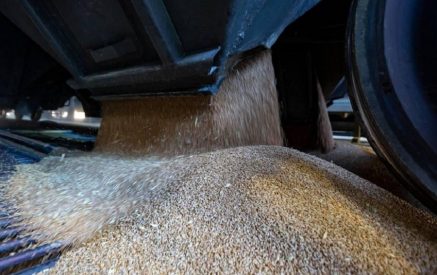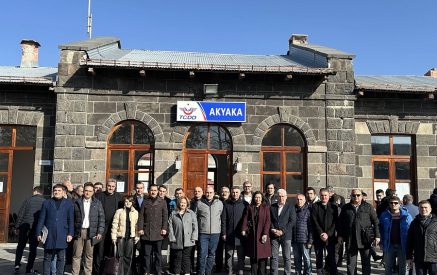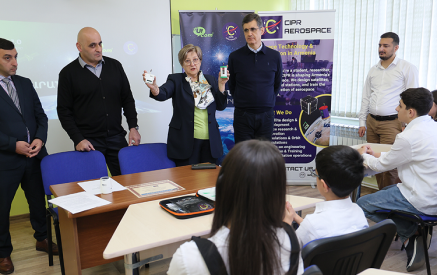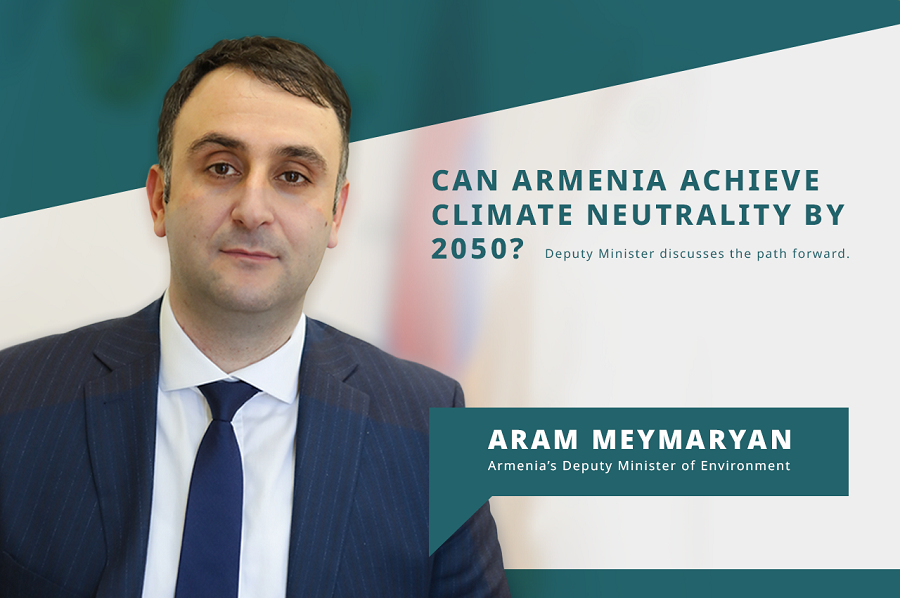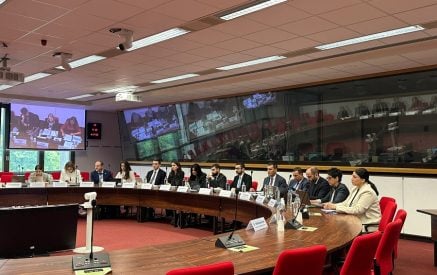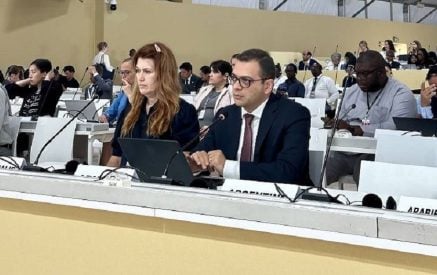As Armenia prepares to host the Green Agenda Armenia Conference 2025, the Green Agenda program team had the opportunity to sit down with Aram Meymaryan, Armenia’s Deputy Minister of Environment, to discuss the country’s path toward climate neutrality. In this conversation, he outlines how European partnerships are shaping Armenia’s environmental policies, the government’s short- and long-term goals, and what it will take to build a resilient, low-emission future.
Q1: How is Armenia improving its environmental policies to align with European standards and work towards climate neutrality?
A: The signing of the Armenia-EU Comprehensive and Enhanced Partnership Agreement (CEPA) has provided the Ministry of Environment with a new platform to enhance the effectiveness of environmental policies. This allows us to integrate these policies into other sectors within our scope of authority, introduce new methods for public awareness, and collaborate with international partners through multiple frameworks and channels.
Q2: Given the strengthening partnership between Armenia and the EU, as well as its member states, how is this relationship helping Armenia to achieve its environmental goals?
Read also
A: As part of the Armenia-EU CEPA roadmap, specifically in the “Environment” and “Climate Change” sections, the Ministry of Environment has committed to implementing 107 measures from 2019 to 2026. These measures aim to align our national legislation with more than twenty EU directives and regulations, advancing in areas such as environmental protection and quality restoration, chemical and waste management, environmental impact assessment and strategic environmental assessment, environmental liability, public access to environmental information, climate change mitigation and adaptation, and ozone layer protection.
Q3: What are the short-term goals Armenia needs to achieve to move towards climate neutrality by 2050? How do these goals align with the country’s National Adaptation Plan and national policies and strategies?
A: Armenia’s long-term low-emission development strategy for greenhouse gases is expected to not only reduce greenhouse gas emissions through 2050, but also positively impact living conditions in local communities by promoting economic growth, social welfare, environmental protection, and enhanced safety. It will also reduce the burden on the healthcare system by lowering the prevalence of chronic illnesses and reducing mortality rates associated with air and water pollution and other causes.
In the short term, the Government-approved Nationally Determined Contributions (NDCs) to combat climate change and increase the country’s resilience are based on green economy principles and align with the Sustainable Development Goals, which are reflected in Armenia’s social and economic development goals. The NDCs were developed with an ecosystem-based approach to mitigation and adaptation, prioritizing balanced and integrated actions.
The implementation of the NDCs is grounded in the objectives and long-term programs established by national and sectoral strategies, such as Armenia’s National Adaptation Plan for Climate Change. Developed and approved in 2021, this plan identified seven vulnerable sectors and coordinates specific measures to address them. The sectors include water resources, energy, agriculture, natural ecosystems, human settlements, tourism, and human health.
Q4: Based on available assessments, air quality is a key concern and indication of environmental problems among the Armenian population. With this regard, what are the priority objectives to reduce CO2 emissions?
A: Although Armenia’s share in global greenhouse gas emissions is less than 0.02%, the Government has announced its ambitions to reduce emissions by setting short-term and long-term goals. In 2021, the Government approved the NDC planning to reduce greenhouse gas emissions by 40% by 2030, compared to 1990 emission levels. In the long term, the Government aims to reduce greenhouse gas emissions to 2.07 tonnes of CO2 equivalent per capita by 2050.
The strategy targets five sectors: 1) energy, including road transport; 2) agriculture; 3) industrial processes and product use; 4) waste; and 5) forestry and land use. By 2030, it is expected that 50 000 new electric vehicles will be imported into Armenia, and by 2050, 400 000 old vehicles will be replaced by electric vehicles, allowing a reduction of CO2 emissions by 11 million tonnes of CO2 equivalent. Additionally, by 2050, the amount of forested area is planned to reach 450 000 hectares, enabling the absorption of a large amount of CO2 gas.
Q5: Armenia is facing environmental challenges due to climate change such as extreme weather, deforestation, and water issues in places like Lake Sevan. What are some of these challenges and how is the country addressing them, especially in terms of water management and conservation?
A: According to analyses, river flow in Armenia may decrease by around 8% to more than 13% by 2040, by 13–27% by 2070, and by 20–39% by 2100. The consequences over a 100-year period may include a 10–30% reduction in soil moisture, a 25–30% increase in soil water deficit, a 24% decrease in the productivity of irrigated land, a 4–10% reduction in the total area and productivity of pastures.
It is anticipated that these changes will negatively impact Armenia’s water resources and other sectors, posing additional challenges for the entire economy. In the energy sector, the direct impact will be observed as reduced river flows affect hydropower production. Rising temperatures and decreased river and lake levels will create obstacles for the cooling mechanisms of nuclear and thermal power plants. Vulnerability in agriculture varies depending on crops and geographic locations. Extreme weather events, rising temperatures, precipitation changes, and water scarcity may affect both livestock and crop production.
Water ecosystems, including the biodiversity of Lake Sevan, are among the priority areas noted as vulnerable to climate change in Armenia’s National Adaptation Plan for Climate Change. In 2022, the Government approved a climate change adaptation program for the water sector with 26 measures, valued at approximately USD 130 million, and a series of technical, legal, institutional, governance, policy, research, and educational or awareness-raising measures are planned through 2026. The technical measures include modernization of irrigation infrastructure, increased hydrological and meteorological data monitoring, and nature-based solutions for flood risk reduction.
Q6: How is Armenia growing its economy and improving people’s lives while also protecting the environment? What steps is the government taking to help people understand and support these efforts?
A: Developing and implementing policies aimed at promoting a green economy and sustainable development is one of the priorities set in the 2021–2026 program of the RA Government in the field of environmental protection. It is precisely this approach that underlies the development of Armenia’s policy for the transition to electric mobility, which, in turn, aims to promote a green and sustainable lifestyle. As a result of this policy, in recent years, there has been a growing interest in electric vehicles, with a sharp increase in imports and use within Armenia.
On the path to transitioning to a green economy, it is essential, among other things, to establish approaches for energy efficiency, the development of the energy sector and transition to low-carbon energy, organic agriculture, sustainable management of water resources and waste, and the shift to green and zero-emission transport.
At the same time, we must have the necessary tools for the implementation of a green economy. Capacity development, improvement of the institutional and legal framework (particularly the effective application of Environmental Impact Assessment (EIA) and Strategic Environmental Assessment (SEA) tools), development of a circular economy, and targeted use of environmental taxes are crucial for building Armenia’s green future.
About the “Green Agenda” Program
The “Green Agenda” program was launched in December 2023 through a joint initiative of the Government of Armenia, the Stockholm Environment Institute, and the Swedish International Development Cooperation Agency.
Armenia has undertaken international commitments to align its policies with the European Green Deal and the Armenia-EU Comprehensive and Enhanced Partnership Agreement. Within the framework of the “Green Agenda,” the program aims to support Armenia in aligning its national policies with leading European standards that guide the transition toward a more sustainable and prosperous future.
During the “Green Agenda Armenia 2025” conference, the results of the National Comprehensive Green Transition Assessment Report for Armenia will be presented, and the planning phase of the “Green Agenda Armenia” program will be launched. This phase will focus on green transition themes, including energy transition, sustainable transport, the “farm to fork” approach, pollution prevention, biodiversity and ecosystems, just transition, digitalization, and more.


